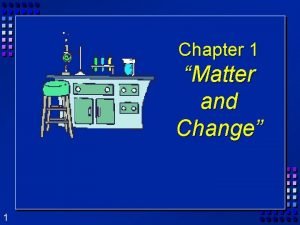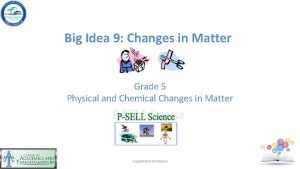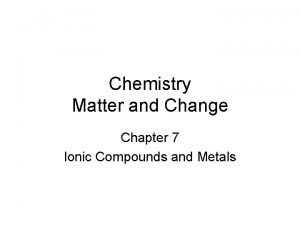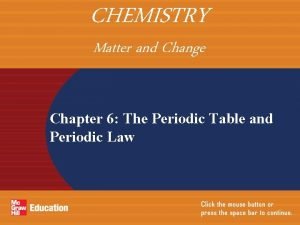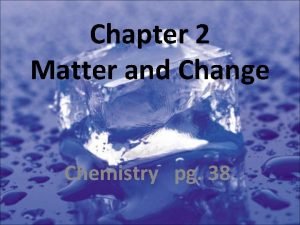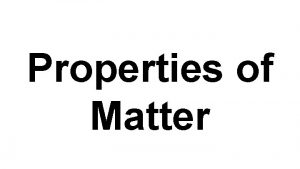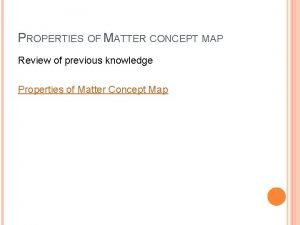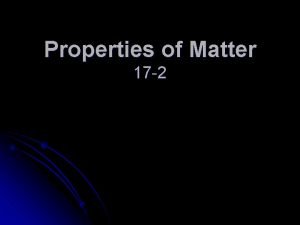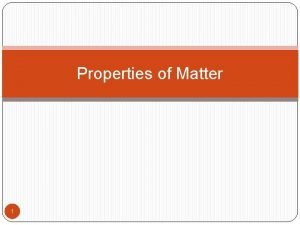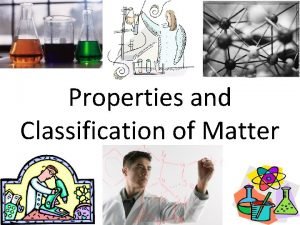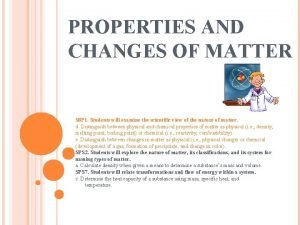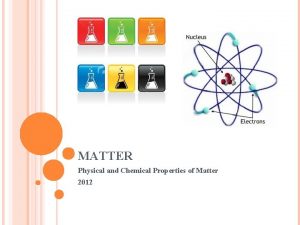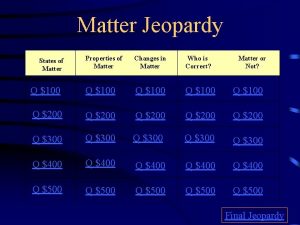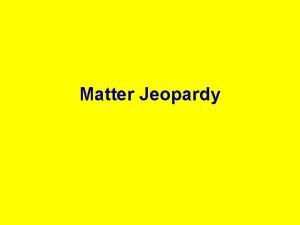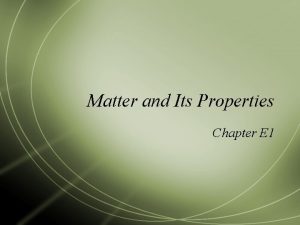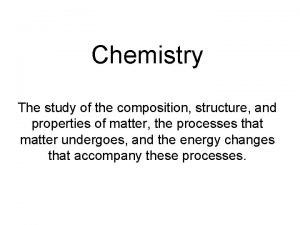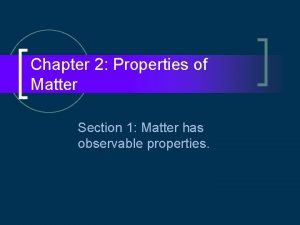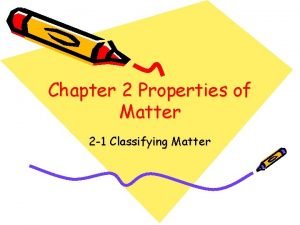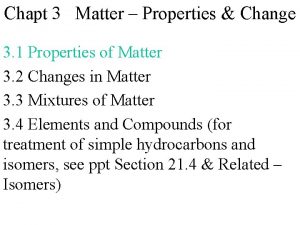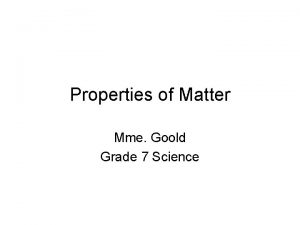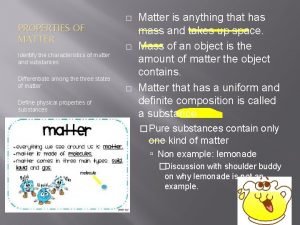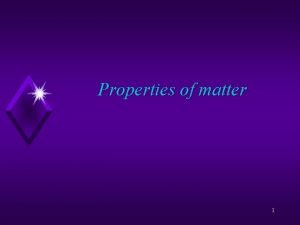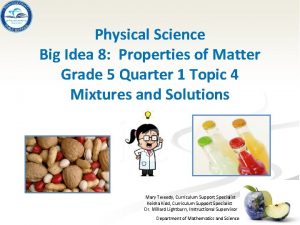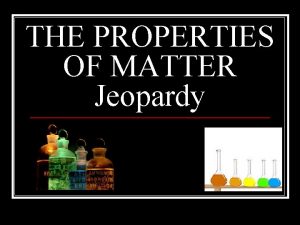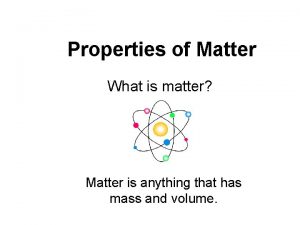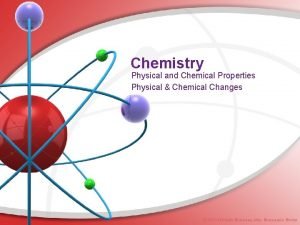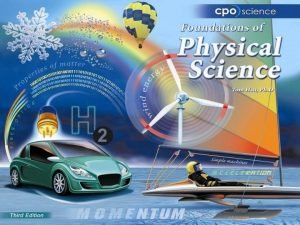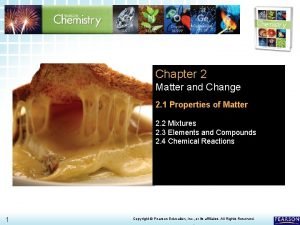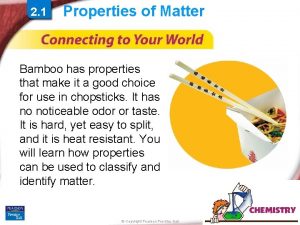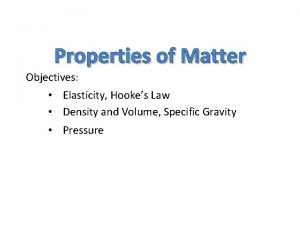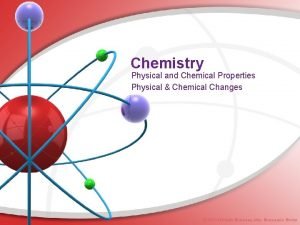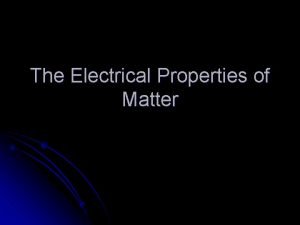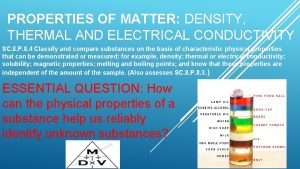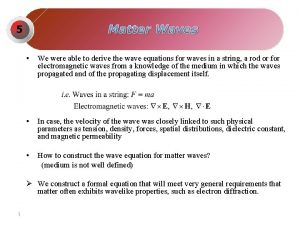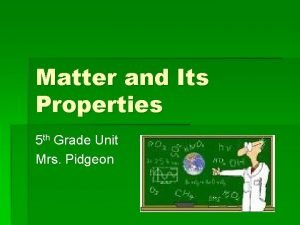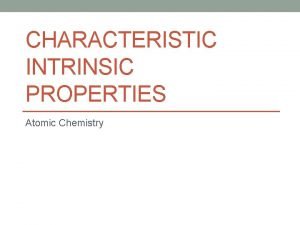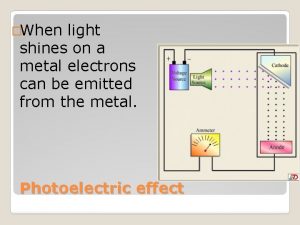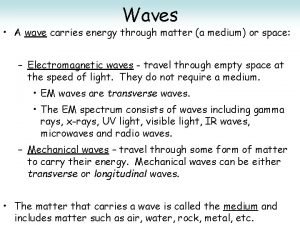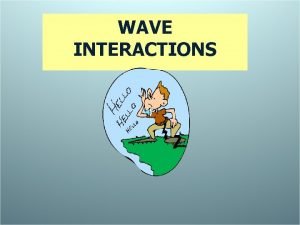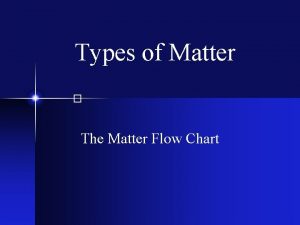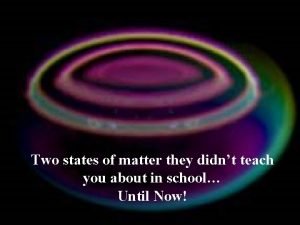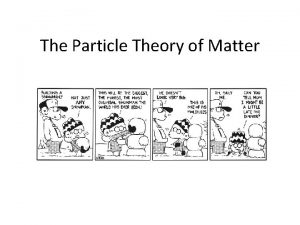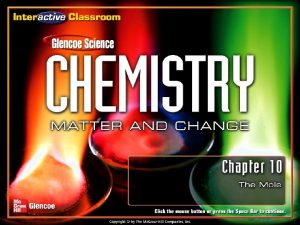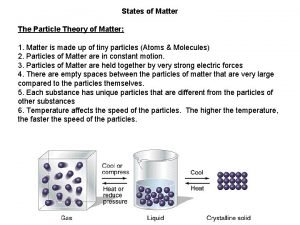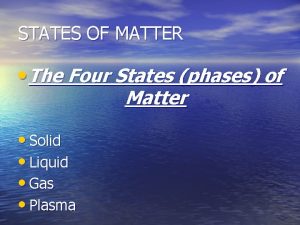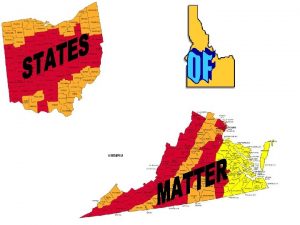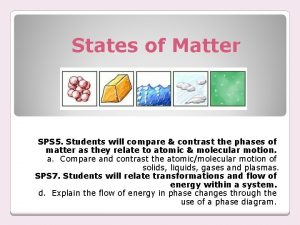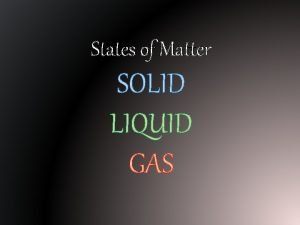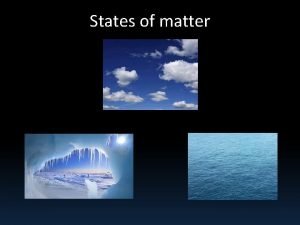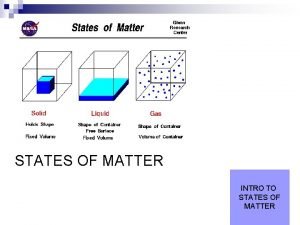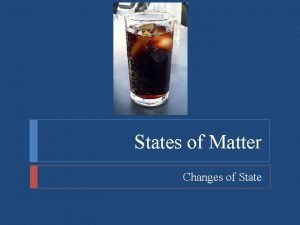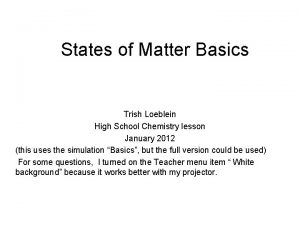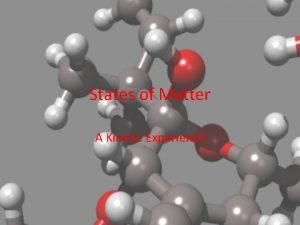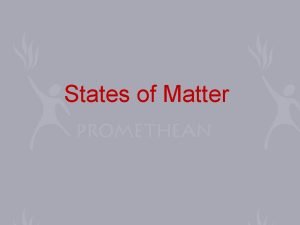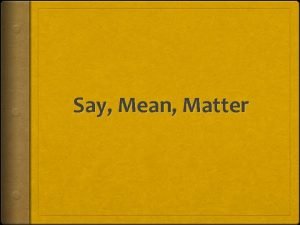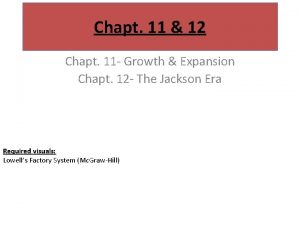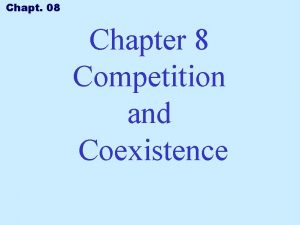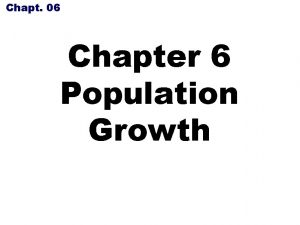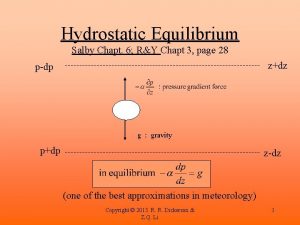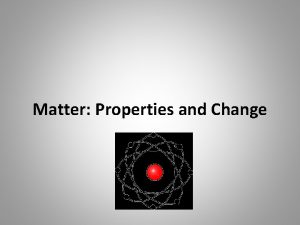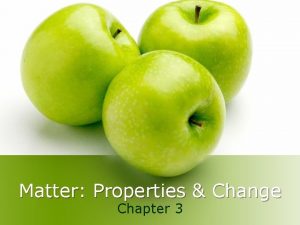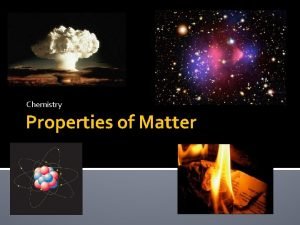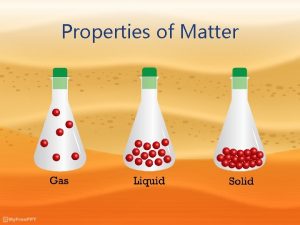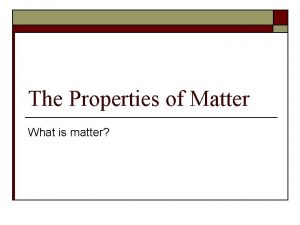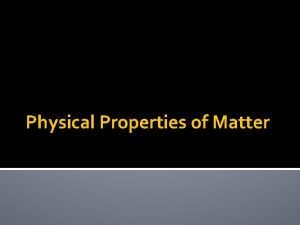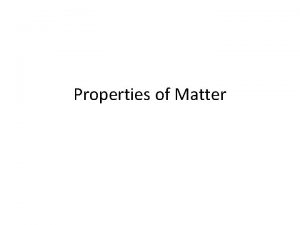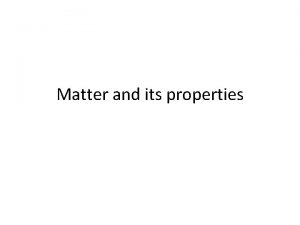Chapt 3 Matter Properties Change 3 1 Properties










![Practice Problem 3 page 75 Classify each of the following as [being related to] Practice Problem 3 page 75 Classify each of the following as [being related to]](https://slidetodoc.com/presentation_image_h/36fe7703edc0e6cfab0b2b19f41e992f/image-11.jpg)






































































































- Slides: 113

Chapt 3 Matter – Properties & Change 3. 1 Properties of Matter 3. 2 Changes in Matter 3. 3 Mixtures of Matter 3. 4 Elements and Compounds (for treatment of simple hydrocarbons and isomers, see ppt Section 21. 4 & Related – Isomers)

Section 3. 1 Properties of Matter Most common substances exist as solids, liquids, and gases, which have diverse physical and chemical properties. • Identify the characteristics of a substance. • Distinguish between physical and chemical properties and changes and be able to give examples of each. • Distinguish between intensive and extensive physical properties and be able to give examples of each type. • Differentiate among the physical states of matter; know the meaning of the term “vapor”.

Section 3. 1 Properties of Matter Key Concepts • The three common states of matter are solid, liquid, and gas. Physical properties can be observed without altering a substance’s composition. • Chemical properties describe a substance’s ability to combine with or change into one or more new substances. • External conditions can affect both physical and chemical properties.

Substance Matter that has a uniform and unchanging composition (aka pure substance) • Copper (Cu – an element) • Salt (sodium chloride, Na. Cl) • Dionized water (H 2 O) Any matter that is not a pure substance is a mixture – see section 3. 3 • Tap water (has dissolved minerals)

States of Matter Solid - Definite shape and volume Liquid - Flows, constant V, takes shape of its container Gas - Conforms to and fills entire volume of container Vapor – gaseous state of room temperature solid/liquid

Physical Properties Can be observed or measured without changing samples composition • Density Color Luster Hardness • Conductivity Melting/boiling points

Physical Properties of Common Substances – Table 3. 1

Extensive/Intensive Properties Extensive – dependent upon amount of substance present Mass Length Volume Intensive – not dependent upon amount Density Pressure Temperature Ignore book example re: scent & spices

Chemical Property Ability of a substance to combine with or change into one or more other substances

Properties of Cu – Table 3. 2 Note distinctions between physical and chemical properties
![Practice Problem 3 page 75 Classify each of the following as being related to Practice Problem 3 page 75 Classify each of the following as [being related to]](https://slidetodoc.com/presentation_image_h/36fe7703edc0e6cfab0b2b19f41e992f/image-11.jpg)
Practice Problem 3 page 75 Classify each of the following as [being related to] a physical or a chemical property: chem a. Iron and oxygen form rust b. Iron is more dense than aluminum phys c. Magnesium burns when ignited chem phys d. Oil and water don’t mix phys e. Mercury melts at 39 C

Chapt 3 Matter – Properties & Change 3. 1 Properties of Matter 3. 2 Changes in Matter 3. 3 Mixtures of Matter 3. 4 Elements and Compounds (for treatment of simple hydrocarbons and isomers, see ppt Section 21. 4 & Related – Isomers)

Section 3. 2 Changes in Matter can undergo physical and chemical changes. • Define physical change and list several common physical changes. • Define chemical change and list several indications that a chemical change has taken place. • Apply the law of conservation of mass to chemical reactions.

Section 3. 2 Changes in Matter Key Concepts • A physical change alters the physical properties of a substance without changing its composition. A chemical change, also known as a chemical reaction, involves a change in a substance’s composition. • In a chemical reaction, reactants form products. • The law of conservation of mass states that mass is neither created nor destroyed during a chemical reaction; it is conserved. massreactants = massproducts

Physical Properties and Changes don’t alter chemical nature Changes in shape from applied mechanical forces • Cut, bend, crumple Phase changes • Melting, boiling, condensation, freezing • Melting and boiling points (see table 3. 1) are intensive physical properties useful in identifying a substance

Chemical Changes In a chemical change (reaction), reactants (R) form products (P) R P New Substances Created • Rusting – Iron (R) to iron oxide (P) • Fermentation – sugar (R) to alcohol (P) • Combustion – methane (R) to CO 2 (P) and H 2 O (P)

Evidence of Chemical Change Rusting; properties that change include: Color: metallic grey brownish orange Attracted to magnet: yes no Chemical reaction always produces a change in properties

Conservation of Mass is neither created or destroyed in a chemical reaction; it is conserved Mass reactants = Mass products Lavoisier (1743 -1794) credited with concept; studied thermal composition of mercury (II) oxide to mercury & oxygen Proof of it depended on development of analytical balance capable of detecting small mass changes

Thermal Decomposition of Hg. O Sum of masses of liquid mercury and gaseous oxygen products equal to original mass of mercury(II) oxide solid 2 Hg. O(s) 2 Hg(l) + O 2(g)

Conservation of Mass Example problem 3. 1 page 78 10. 00 g Hg. O heated to produce 9. 26 g Hg Mass of oxygen formed in reaction? Knowns: m. Hg. O = 10. 00 g m. Hg = 9. 26 g Unknown: m. O 2 ? mreactants = mproducts Law of Conservation of Mass m. Hg. O = m. Hg + m. O 2 = m. Hg. O m. Hg m. O 2 = 10. 0 g 9. 26 g = 0. 74 g of oxygen 2 Hg. O(s) 2 Hg(l) + O 2(g)

Practice Conservation of mass Problems 5 – 9 page 78 Problems 13(a-b) page 79 Problems 50 – 55 pages 94 - 95

Chapt 3 Matter – Properties & Change 3. 1 Properties of Matter 3. 2 Changes in Matter 3. 3 Mixtures of Matter 3. 4 Elements and Compounds (for treatment of simple hydrocarbons and isomers, see ppt Section 21. 4 & Related – Isomers)

Section 3. 3 Mixtures of Matter Most everyday matter occurs as mixtures —combinations of two or more substances. Objectives • Define and distinguish between substances and mixtures. • Define and distinguish between homogeneous and heterogeneous mixtures and be able to give examples of each. • Classify and give examples of the seven different types of solutions (3 possible states for the solution and 3 combinations of phases of solute and solvent for the liquid and solid phase solutions).

Section 3. 3 Mixtures of Matter Objectives (cont) • Name and describe various mixture separation techniques and identify which technique would be most appropriate for a given separation problem. • Describe the role that mobile and stationary phases play in chromatographic separation techniques. • Describe how affinity differences play a role in liquid-liquid and chromatographic separation techniques. [material only partially in textbook]

Section 3. 3 Mixtures of Matter Key Concepts • A mixture is a physical blend of two or more pure substances in any proportion. • Solutions are homogeneous mixtures. • Mixtures can be separated by physical means. Common separation techniques include filtration, distillation, crystallization, sublimation, and chromatography.

Matter – Classification Scheme

Mixtures Combination of two or more pure substances in which each pure substance retains its individual chemical properties • Composition variable • Number of possible mixtures is infinite • Most everyday matter occurs as mixture

Mixtures - Types Heterogeneous • Not smoothly blended [may appear to be just by looking at it but will not be at the microscopic level] • Individual substances remain distinct ² Sand & water ² Paint, mayonnaise [heterogeneous at a microscopic level – not all heterogeneous mixtures are readily identified as such by the naked eye]

Mixtures - Types Homogeneous • Constant composition throughout – even down to the microscopic level • Single phase (gas, liquid or solid) [although heterogeneous mixtures can also be a single phase such as a water/oil emulsion] • More commonly used term is solution ² Salt & water

Mixtures and Compounds Iron and Sulfur S Fe Physically mixed - can be separated by physical means React chemically cannot be separated by physical means

Solutions - Types Table 3. 3 “Types of Solution Systems” from the textbook; table 3. 3 is not completely correct Liquid-gas example wrong – water droplets are 2 nd phase (incompatible with definition of solution) Liquid-liquid example misleading – seawater itself is a solution of a solid dissolved in liquid water, so liquid is same for both; much better example is solution formed from 2 pure liquids, such as a solution of isopropyl alcohol in water (what you get from a drugstore)

Solutions - Types On the next slide is an expanded (and correct) version of Table 3. 3 1 st column is phase of solution itself 2 nd column is phase of solute – the “stuff” that is being dissolved in the solvent to form the solution By definition there is less of the solute than there is of the solvent 3 rd column is phase of solvent Can dissolve both gas & liquid in a solid!

Types of Solutions Ph Solute Solvent ase (Minor) (Major) G Gas Example Air – N 2, O 2, Ar L Gas Liquid Soda – CO 2 /H 2 O L Liquid Antifreeze – Glycol / H 2 O L Solid Liquid Salt water S Gas Solid H 2 in Pd or Pt S Liquid Solid Dental Amalgam (Hg/Ag) S Solid Brass (Cu/Zn alloy)

Solutions The following 3 slides are intended as examples of how common substances such as air and water can be more complicated than one might expect You are not expected to know the actual compositions

Composition of Dry Air (Solution)

Layers of Atmosphere Solution with continuously variable composition Horizontally homogeneous (sort of – lots of point sources of pollutants) Vertically inhomogeneous but still a solution in local region

Substances Found in Natural Waters Any natural water (tap or bottled) is a complicated homogeneous mixture (a solution) and if dust and sand/soil particles are counted, is a heterogeneous mixture

Separating Mixtures Take advantage of differing physical properties Filtration – heterogeneous mixture • Solid from liquid Distillation – typically liquid-liquid solutions; also solid-liquid (salt water) • Depends upon difference in boiling points • Most volatile (lower bp) material removed 1 st Crystallization – liquid-solid solutions • Remove enough solvent so solubility of solute exceeded – very high purity crystals possible

Separating Mixtures Sublimation (Phase change process in which solid changes directly into vapor) – can use in separation of solids if only one sublimates [extremely limited in actual practice] Chromatography – separates components of mixture (mobile phase) based on ability of each component to travel across surface of another material (stationary phase) [this is most widely used separation technique in chemistry]

Filtration Good for Solid/Liquid Separations

Selective Crystallization When KNO 3(s) crystallized from aqueous solution of KNO 3 containing Cu. SO 4 (blue) as an impurity, Cu. SO 4 remains in solution KNO 3 (white) crystallized from hot, saturated solution is virtually pure

Zone Refining of Silicon Purification by Crystallization Heated (melted) zone moving left to right

Simple Distillation Separation technique based on differences in boiling points (BPs) of substances involved – physical process, not chemical Distillation often synonymous with “simple” distillation; single evaporation followed by condensation of vapors Simple distillation - works well when BPs differ by ≥ 25 C (rule of thumb) Batch technique (single filling of apparatus)


Gasoline vapors Fractional Distillation of Crude Oil Condenser Gasoline 38 o. C Kerosene 150 o. C Heating oil 260 o. C Lubricating oil 315 o. C - 370 o. C Crude oil from heater Steam Residue (asphalt, tar)

Separating Mixtures Forces exist between molecules Details of molecular shape, size, and charge influence magnitude of force between any 2 molecules For example, there are strong forces between oppositely charged molecules (ions)

Separating Mixtures Forces between certain types of molecules are stronger than for other types of molecules • Ones with stronger forces said to have an affinity for each other Can use affinity differences as basis for a separation technique

Separating Mixtures - Partitioning Solution with A & B dissolved in water If A has higher affinity for another solvent than B does, can exploit to separate A & B If water & 2 nd solvent in contact, A will tend to concentrate in 2 nd solvent A & B said to partition between the 2 solvents – basis for liquid-liquid extraction process

Liquid-Liquid Extraction Add 2 nd Wait for 2 substances immiscible partitioning, then dissolved in (insoluble) drain off bottom water solvent & shake S 2 S Separatory Funnel S S 1


Chromatography Can exploit affinity differences in different way by using chromatography Key to technique is mobile (moving) phase and a stationary phase Molecules separate out on basis of their affinity for stationary phase A A BB B B B A A Stationary Phase A A

Chromatography Important and widely used technique Many types: (m)=mobile (s)=stationary • VPC vapor phase – gas (m)/liquid (s) • LPC liquid phase – liquid(m)/solid(s) • Paper – liquid(m)/paper(s) • HPLC – high pressure LPC • IEC – ion exchange – ions (m)/resin(s) Lots of others, often coupled with other types of instruments

Paper chromatography of ink (a) Line of mixture to be separated placed at one end of sheet of porous paper

Paper chromatography of ink (b) The paper acts as wick to draw up liquid

Paper chromatography of ink (c) Component with weakest attraction (least affinity) for paper travels faster than components that cling to paper (have high affinity for paper)

Column Chromatography

Gas Chromatography

Detector Response Chromatographic Data time or volume Data (chromatogram) is usually represented as a plot of “some” detector response as a function of either time or volume (chromatos = color)

Chapt 3 Matter – Properties & Change 3. 1 Properties of Matter 3. 2 Changes in Matter 3. 3 Mixtures of Matter 3. 4 Elements and Compounds (for treatment of simple hydrocarbons and isomers, see ppt Section 21. 4 & Related – Isomers) Note: Laws of Definite Proportion & Multiple Proportion are included just for completeness but will be actually discussed when studying chapter 10 (The Mole)

Section 3. 4 Elements and Compounds A compound is a combination of two or more elements. Objectives • Define and distinguish between elements and compounds and recognize that a compound’s properties can be very different from the properties of its constituent elements. • Identify a method for separating a compound into elements. • Classify a given material as a mixture or a pure substance and to further classify it as homogeneous or heterogeneous mixture or as an element or as a compound. Should also be able to give an example of each category • Describe the organization of elements in the periodic table. • Identify the number of currently recognized elements and the number of naturally occuring elements

Section 3. 4 Elements and Compounds Objectives (cont) • Name the two most abundant elements in the universe and the five most abundant elements in the Earth’s crust, atmosphere and oceans (both sets in order of relative abundance). [Material not entirely in book] • Distinguish between common & systematic chemical names. • Name and describe the commonly used chemical identifiers • Explain the value of a CAS registry number (or other comparable chemical identifiers) in finding information on existing compounds. [Material not in book] • Identify the SMILES and In. Ch. I strings as chemical identifiers that are based on chemical structure and describe the advantages of these identifiers. [Material not in book]

Section 3. 4 Elements and Compounds Key Concepts • Elements cannot be broken down into simpler substances. • Elements are organized in the periodic table of the elements. • Compounds are chemical combinations of two or more elements and their properties differ from the properties of their component elements. • Chemical registry numbers and other chemical identifiers help avoid some problems with complicated chemical names and make it easier to find information about compounds. In some cases, they provide a way to look for information based on the compound’s structure.

Matter – Classification Scheme

Elements Pure substance that can’t be separated into simpler substances by physical or chemical means 92 naturally occurring elements (Tc, # 43, only in trace amounts - unstable) – remaining elements must be synthesized

Elements have name and chemical symbol Named elements have 1 or 2 letter symbol with only 1 st letter capitalized (C, Au, Pt) Unnamed or undiscovered elements given 3 letter placeholder (temporary) symbol (Uut, Uuo) and latin or latin/greek name for its atomic number Uuo = Ununoctium = latin for 118 + “ium”

Elements – Periodic Table Organized into periodic table of elements (see end of book or pages 178 -9) ordered by atomic number (number of protons in nucleus); currently 114 named elements Columns (vertical) = groups or families Elements in same group tend to have similar chemical and physical properties Rows (horizontal) = periods Table “periodic” because pattern of variation of properties repeats in each period

Elements - Newest Elements with atomic numbers 114 and 116 officially named 5/2012 as Flerovium (Fl) and Livermorium (Lv), respectively. Copernicium (Cn), atomic number 112 officially named 2/2010. Elements 113, 115, 117 (newest – April 2010), 118 have claimed to have been made, but evidence not yet convincing enough for official recognition by IUPAC Official current total = 114 elements

Periodic Table of Elements Each box shows atomic number and the element’s symbol Newest elements Fl & Lv; remainder claimed to have been made but have not been officially recognized as existing

Periodic Table – Basic History Original form of table published by Russian chemist Dmitri Mendeleev in 1869 Based on similar properties and ordered by element masses Has since been refined – see chapter 6 (The Periodic Table and Periodic Law)

Elements - Abundance Hydrogen most abundant and helium second most abundant elements in universe (H estimated to make up ~ 75% of mass of universe) Statistics for elemental abundance on Earth focused on composition of Earth’s crust, its oceans and its atmosphere Top five elements in order: O Si Al Fe Ca

Compound and Chemical Formula Formed from 2 or more elements that are combined chemically (bonded to one another) • Exception: S 8 (1 element compound) Simple compounds clearly and uniquely Identified by chemical formula - created from chemical symbols of elements and subscripts indicating number of atoms of that element • H 2 O Na. Cl CH 4 Ca. SO 4

Overview – Identifying Compounds Ways of identifying a compound include: 1. Chemical formula 2. Chemical name a. Common name b. Systematic Name 3. Chemical structure (drawing) 4. Other (to be described) Will use the term “chemical identifier” to refer to any of the above choices

Chemical Formula and Isomers As compounds become more complex (especially organic ones), the chemical formula does not uniquely represent a single compound Isomers – different compounds which have same chemical formula Details are in Power. Point presentation “Chapt 21 – Hydrocarbons [selected]” which covers simple alkanes and isomers of alkanes and other organic compounds

Systematic vs Common Names Common names (water, aspirin) convey little to no chemical information Elaborate rules exist for assigning names to chemical substances on basis of their structures – called systematic names Systematic (rule-based) names uniquely identify given substance; rule definitions = system of chemical nomenclature

Chemical Nomenclature http: //en. wikipedia. org/wiki/IUPAC_nomenclature Developed and kept up to date under auspices of International Union of Pure and Applied Chemistry (IUPAC), which publishes official (systematic) rules for naming organic and inorganic compounds Primary aim - provide methodology for assigning descriptors (names and formulas) to chemical species so that they can be identified without ambiguity

Compound Names Given substance may have several common or trivial names; ordinary cane sugar, for example, is more formally known as "sucrose“ Formal, systematic name for sucrose is α-D-glucopyranosyl-(1, 2)-β-D-fructofuranoside

Compound Names - Drawbacks Problems associated with names: 1. They aren’t necessarily unique; can be multiple ways of naming a given compound using the official rules of chemical nomenclature 2. For even moderately complicated compounds, can be difficult to figure out the correct name 3. Long, complex names are difficult to use in a search engine

Chemical Information & Databases To find information about a substance from formal chemical database or from a less structured source of information (Google), need to be able to identify the substance using some sort of chemical identifier Identifier could be common chemical name (table sugar, sucrose), a systematic chemical name [α-D-glucopyranosyl-(1, 2)-β-Dfructofuranoside] or some alternate chemical identifier (like using SS number in place of person’s name to obtain data about a person)

Chemical Databases & Identifiers Indexing of structure, composition and properties of new & existing compounds done by several organizations To get around problem of complicated and multiple names for a substance, major databases of chemicals use chemical registry numbers, accession numbers or other chemical identifiers not based on name; some of these chemical identifiers are based directly on molecular structure

Chemical Databases & Identifiers Chemical Abstracts Service (CAS) Registry Numbers are most commonly encountered chemical identifier for compounds (especially in US); also known as CAS RNs or CAS Numbers Other registries and their associated chemical identifiers exist and offer alternatives / advantages to CAS numbers Use of structure-based identifiers has accelerated over past 5 – 10 years

Compounds & CAS Registry Numbers http: //en. wikipedia. org/wiki/Chemical_abstracts http: //www. cas. org/index. htm Number itself has no inherent chemical significance but provides an unambiguous, unique way to identify a chemical substance or molecular structure when there are many possible systematic, generic, proprietary, or trivial names

Compounds & CAS Registry Numbers CAS number can contain up to 10 digits, divided by hyphens into 3 parts Right most digit is a check digit used to verify the validity and uniqueness of number Examples: • Na. Cl • H 2 O CAS [7647 -14 -5] CAS [7732 -18 -5]

Using CAS Number or Name Many online databases will accept a CAS numbers as a search term Wolframalpha (computational knowledge engine) accepts CAS numbers to provide extensive compound information – see example on left side of following slide Right hand side of slide shows result from entering a compound name (benzoic acid); CAS number shown as part of output http: //www. wolframalpha. com/

Compounds from Wolfram Search http: //www. wolframalpha. com/input/? i=benzoic+acid

Other Registry Numbers and IDs Wolframalpha and many other sources return a list of “chemical identifiers” – alternate ways that compound is indexed or described; benzoic acid identifiers:

Other IDs for Benzoic Acid - Wolframalpha

Other IDs for Benzoic Acid - Wikipedia First hit from Google search on benzoic acid is Wikipedia article

Chemical IDs Listed by Wikipedia Most important / widely used (not specific to a particular database) CAS number – Chemical Abstracts Service Registry Number In. Ch. I - textual identifier (text string) for chemical substances that represents chemical structures SMILES – similar to In. Ch. I

CAS Number & Chemical Name - Lipitor CAS 134523 -00 -5 Atorvastatin (lowers cholesterol) [R-(R*, R*)]-2 -(4 -fluorophenyl)- , -dihydroxy-5 -(1 methyl)-3 -phenyl-4 -[(phenylamino)carbonyl]-1 Hpyrrole-1 -heptanoic acid OR (3 S, 5 S)-7 -[2 -(4 -fluorophenyl)-3 -phenyl-4(phenylcarbamoyl)-5 -propan-2 -ylpyrrol-1 -yl]-3, 5 dihydroxyheptanoic acid

Structure-Based Chemical Identifiers Most direct is to draw compound’s structure (various ways of doing this) Alternative is to encode connectivity (what’s connected to what) of atoms within a molecule into a text string Two main string based IDs: SMILES and In. Ch. I (IN chee)

SMILES http: //en. wikipedia. org/wiki/Simplified_molecular_input_line_entry_specification Simplified molecular input line entry specification - form of a line notation for describing structure of chemical molecules using short ASCII character strings OC(=O)C(N)CC 1=CC=C(O)C=C 1 is an example of a SMILES strings can be imported by most molecule editors for conversion back into 2 D drawings or 3 D models of molecules

IUPAC International Chemical Identifier http: //en. wikipedia. org/wiki/International_Chemical_Identifier In. Ch. I - textual identifier for chemical substances, designed to provide standard and human-readable way to encode molecular information & to facilitate database searches for such information XML-based text coding system for chemical structure; codes are unique and capable of representing detailed and nuanced features of chemical structures for robust chemical structure representation

IUPAC International Chemical Identifier http: //en. wikipedia. org/wiki/International_Chemical_Identifier Examples of what are called “Standard In. Ch. I “ strings:

Chemical Identifiers for Isoprene Molecular formula: C 5 H 8 Systematic names: 2 -Methylbutadiene; 2 -Methyl-1, 3 -butadiene Common names: Isoprene; Isopentadiene CAS RN: 78 -79 -5 SMILES: C=CC(C)=C; C(C)=CC=C; C(C=C)C=C; C=C(C=C)C In. Ch. I: 1/C 5 H 8/c 1 -4 -5(2)3/h 4 H, 1 -2 H 2, 3 H 3

Advantages of Structure-Based IDs CAS RNs and similar registry numbers for other databases can only be used for existing compounds that have been registered by that database Stucture-based IDs (In. Ch. I, SMILES) can encode compounds that might not exist In addition, they allow for powerful structurebased searches such as “find existing compounds that have structures similar to my target compound”

Compound Identification - Summary Chemical formula (Na. Cl, C 3 H 8) OK for small compounds but not for larger organics – many, many compounds have same formula (isomers) Common and formal chemical names (sodium chloride, propane) OK for small compounds but difficult for non-specialists to determine correct name for larger ones unless use computer and input structure

Compound Identification - Summary Registry numbers (CAS, etc. ) good way to access information about existing compounds from chemical databases In. Ch. I Chemical ID provides means to generate searchable ID from structure SMILES Similar to In. Ch. I – encodes structure in text string Structural formulas (easiest to digest)

Decomposing Compounds Cannot break down into components by physical means, but sometimes can by chemical means – requires input of energy because compound is more stable than its separate component elements Electrolysis considered to be an example of a chemical process (doesn’t involve chemicals but does cause chemical change) that breaks down a compound – most common example is water electrolysis

Separating Water into Hydrogen and Oxygen Using Electrolysis

Separating Water into Hydrogen and Oxygen Using Electrolysis

Compounds Properties can be quite different than component elements See following slide on reaction of Na metal with chlorine gas to form Na. Cl

Some Properties of Sodium, Chlorine, and Sodium Chloride

Remainder of this section will be treated when doing chapter 10 (The Mole)

Law of Definite Proportions Regardless of amount, compound composed of same elements in same proportion by mass statement that compound’s formula doesn’t change with amount of compound present • H 2 O = formula for water no matter how much water you have – proportions always same, mole ratio same, mass ratios same

Law of Definite (or Constant) Proportion (or Composition) Both sources of calcium carbonate (Ca. CO 3) have same % composition

Law of Definite Proportions Focus here is % composition from some chemical analysis % by mass = 100 mass element mass compound

Law of Definite Proportions % by mass = 100 mass element mass compound Analysis of 20. 00 g & 500. 0 g samples same have same composition

Practice Mass % & Law of Definite Proportions Problems 19 - 23, page 88 Problem 29, page 90 Problems 72(a-b), 74 – 76 page 95 Problems 78, 80 page 96

Law of Multiple Proportions If elements form >1 compound, those compounds will have compositions that are small, whole-number multiples of each other Focus: ratio of mass ratios = integer Water vs Hydrogen Peroxide H 2 O (O: H 16: 2) vs H 2 O 2 (O: H 32: 2) • Ratio of Mass ratios O: H (H 2 O 2) / O: H (H 2 O) = 2: 1

Atomic Basis of Law of Multiple Proportions Ratio of number of atoms within each compound is integer ratio of mass ratios of compounds must be same integer

Law of Multiple Proportions Copper Chloride Compounds Compound II Cpd % Cu % Cl Mass Ratio: cpd I ratio Cu : Cl to cpd II ratio I 64. 20 35. 80 1. 793 : 1 II 47. 27 52. 73 0. 8964 : 1 2. 000

Practice Law of Multiple Proportions Problems 27 - 28, page 90 Problems 77, 79 page 90

End of Chapter
 Section 1 composition of matter
Section 1 composition of matter Gray and white matter
Gray and white matter Classification of matter section 1 composition of matter
Classification of matter section 1 composition of matter Chapter 2 section 1 classifying matter answer key
Chapter 2 section 1 classifying matter answer key Median and lateral apertures
Median and lateral apertures Composition of matter section 1
Composition of matter section 1 Gray matter and white matter
Gray matter and white matter Telencephalon
Telencephalon Ecological succession
Ecological succession Chemistry matter and change chapter 7
Chemistry matter and change chapter 7 Chemistry matter and change chapter 10
Chemistry matter and change chapter 10 Chapter 1 review matter and change
Chapter 1 review matter and change Change of state of matter
Change of state of matter Types of change in matter
Types of change in matter Changes in matter grade 5
Changes in matter grade 5 1s 22 s22 p63 s23 p64 s2
1s 22 s22 p63 s23 p64 s2 Chemistry matter and change chapter 6
Chemistry matter and change chapter 6 Chemistry matter and change chapter 10
Chemistry matter and change chapter 10 Chemistry matter and change answer key chapter 2
Chemistry matter and change answer key chapter 2 Unit 2 matter and change
Unit 2 matter and change Chapter 1 matter and change worksheet answers
Chapter 1 matter and change worksheet answers Properties of liquid in matter
Properties of liquid in matter Properties of matter vocabulary
Properties of matter vocabulary Matter concept map
Matter concept map Objectives of properties of matter
Objectives of properties of matter General property of matter
General property of matter Classification and properties of matter
Classification and properties of matter Properties and changes of matter worksheet
Properties and changes of matter worksheet Measurable properties of matter
Measurable properties of matter Properties of matter jeopardy
Properties of matter jeopardy Properties of matter jeopardy
Properties of matter jeopardy Properties of matter volume
Properties of matter volume Matter and its properties
Matter and its properties Classification of matter graphic organizer
Classification of matter graphic organizer The study of composition structure and properties
The study of composition structure and properties Chemical properties of matter
Chemical properties of matter 2 properties of matter
2 properties of matter Name two categories used to classify properties of matter
Name two categories used to classify properties of matter Matter-properties and changes answer key
Matter-properties and changes answer key Properties of matter vocabulary
Properties of matter vocabulary Classification of matter grade 7
Classification of matter grade 7 Properties and characteristics of matter
Properties and characteristics of matter General properties of matter
General properties of matter Which is a “big idea” of physical science?
Which is a “big idea” of physical science? Properties of water in matter
Properties of water in matter Physical properties of matter jeopardy
Physical properties of matter jeopardy Materials that are useful but can also be harmful
Materials that are useful but can also be harmful Properties of matterwhat is matter?
Properties of matterwhat is matter? Chemical properties of notebook paper
Chemical properties of notebook paper General properties of solids
General properties of solids Chapter 2 properties of matter answer key
Chapter 2 properties of matter answer key Bamboo basket properties of matter
Bamboo basket properties of matter Properties of matter elasticity
Properties of matter elasticity Grade 7 natural science term 2 worksheets
Grade 7 natural science term 2 worksheets Qualitative properties of matter
Qualitative properties of matter Electrical properties of matter
Electrical properties of matter Properties of matter objectives
Properties of matter objectives Are thermal and electrical conductivity related
Are thermal and electrical conductivity related What are matter waves
What are matter waves Kwl chart properties of matter
Kwl chart properties of matter Properties used to describe matter
Properties used to describe matter Intrinsic properties of matter
Intrinsic properties of matter Is mashing potatoes a chemical change
Is mashing potatoes a chemical change What are physical changes
What are physical changes Absolute change and relative change formula
Absolute change and relative change formula What is integer number
What is integer number Difference between a chemical and physical change
Difference between a chemical and physical change Input and output markets
Input and output markets Change in supply and change in quantity supplied
Change in supply and change in quantity supplied Enagic compensation plan
Enagic compensation plan Proactive and reactive change
Proactive and reactive change What is an example of chemical and physical change
What is an example of chemical and physical change Spare change physical versus chemical change
Spare change physical versus chemical change Rocks change due to temperature and pressure change
Rocks change due to temperature and pressure change Whats chemical change
Whats chemical change How does a physical change differ from a chemical change? *
How does a physical change differ from a chemical change? * Physical or chemical change
Physical or chemical change First-order and second-order change examples
First-order and second-order change examples Why is chopping wood a physical change
Why is chopping wood a physical change Climate change 2014 mitigation of climate change
Climate change 2014 mitigation of climate change Extensive vs intensive
Extensive vs intensive Chemical property of water
Chemical property of water Why business models matter
Why business models matter Does it matter what type of light shines on the metal
Does it matter what type of light shines on the metal Phases of matter foldable
Phases of matter foldable Definition of economics by adam smith
Definition of economics by adam smith Type of wave
Type of wave Waves transfer energy without transferring matter
Waves transfer energy without transferring matter Matter flow chart
Matter flow chart Plasma and bose-einstein condensate
Plasma and bose-einstein condensate Communication matter
Communication matter Matter form and minister of eucharist
Matter form and minister of eucharist Closely packed in an orderly manner
Closely packed in an orderly manner The mole lesson 9.1 measuring matter
The mole lesson 9.1 measuring matter Subject matter of psychology
Subject matter of psychology Chemical equations with states of matter
Chemical equations with states of matter Four phases of matter
Four phases of matter Four states of matter
Four states of matter 5 states of matter
5 states of matter States of matter thermal energy
States of matter thermal energy Stayes of matter
Stayes of matter Sixth state of matter
Sixth state of matter All matter is in constant motion
All matter is in constant motion Plasma state of matter examples
Plasma state of matter examples Changing state
Changing state Phet states of matter basics
Phet states of matter basics 5 states of matter
5 states of matter 4 phases of matter
4 phases of matter Soil is a mixture of weathered rock and
Soil is a mixture of weathered rock and Verstehen qualitative research
Verstehen qualitative research Say mean matter chart examples
Say mean matter chart examples Say mean matter graphic organizer
Say mean matter graphic organizer Solid to gas examples
Solid to gas examples The kinetic theory of matter states that
The kinetic theory of matter states that











